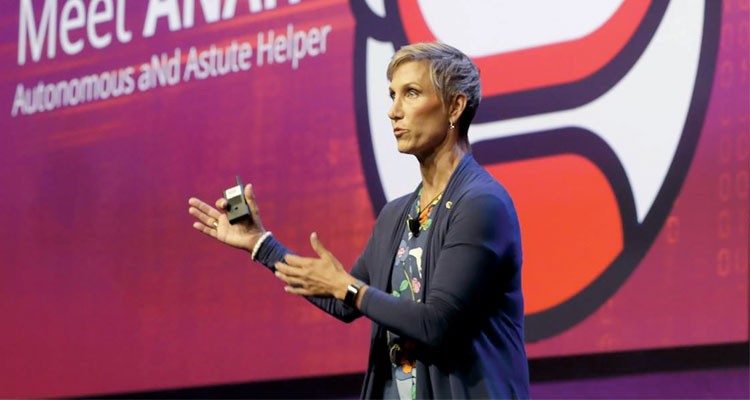- Change When Already Winning
- Executive Profiles
- Featured
- IQ Insigniam Quarterly® Magazine
- Transformational Leadership
Hitachi Vantara’s Change Mandate
Hitachi Ltd. is proof that evolution fuels longevity. The 109-year-old Tokyo-based conglomerate got its start manufacturing electric motors for copper mines. Today its 844 subsidiaries around the world make an extraordinary range of products: everything from elevators to excavators, ATMs to air conditioners, software to steel. Together these products generate about $88 billion in annual revenue—and another valuable asset: data.
The company has for decades been capturing extensive data detailing things like product performance and maintenance trends. Only recently, however, did it begin viewing all that information as raw material that can be leveraged to reveal patterns that can help predict equipment service needs.
“We hoarded it, we stored it, but we didn’t realize the value of mining it,” Renée McKaskle says.
She is the CIO of Hitachi Vantara. Its purpose is to help commercial and industrial enterprises “extract all the value their data has to offer,” according to a September 2017 press release announcing the new company. But her massive first task has been to unlock the power of Hitachi Vantara’s own data. To that end, she is leading a two-year transformation initiative to help optimize IT services at Hitachi Vantara and extend those benefits across the entire Hitachi organization.
“As a company that delivers data-driven solutions for enterprises,” Ms. McKaskle says, “Hitachi Vantara is all about the power of our company’s data.”
Following leading IT roles at SC Johnson, Symantec and Oracle, she was hired in 2015 as CIO of Hitachi Data Systems, the $4 billion subsidiary that manufactured data storage systems and software. At the time, Hitachi had strength in IT as well as operational technology products and services. As the world entered the internet of things (IoT) era, Hitachi was looking for a way to help companies unlock the value of their data to transform their business and positively contribute to society.
“You have to be passionate about what you do. If you don’t have a fervent voice helping you through the daily grind, you will miss all the fun.”
—Renée McKaskle, CIO, Hitachi Vantara
The solution: become a global IoT leader. To achieve this, Hitachi Ltd. needed to reorient its IT businesses around the new approach—and a new company. So it merged the data infrastructure assets of Hitachi Data Systems with the data software expertise of Hitachi Insight Group and the analytics capabilities of Pentaho to form Hitachi Vantara. Helping drive Hitachi Vantara’s internal transformation, which the company dubbed Mirai (Japanese for “future”), presents not only a career-defining leadership opportunity for Ms. McKaskle. It showcases the deep value that CIOs can deliver as change agents.
“CIOs and technology executives have never been more in the spotlight in a good way,” she says. “We’re no longer viewed as a corporate IT function—we are strategic IT.”
Ms. McKaskle is a rare CIO who is a top-rate technologist, business strategist and human-centered transformational leader, says Insigniam Partner Scott W. Beckett, PhD. “She is clear that no matter the strategic or technical choices made, success all comes down to people being able to catalyze and then deliver on what is critical for the enterprise.”
The Road to Competitive Advantage
 The open secret of the much-trumpeted big data era is that most of the data companies generate is never tapped for value. (Between 60 and 73 percent goes unused for analytics, according to Forrester.) Sales of every product Hitachi manufactures produce valuable data, Ms. McKaskle notes.
The open secret of the much-trumpeted big data era is that most of the data companies generate is never tapped for value. (Between 60 and 73 percent goes unused for analytics, according to Forrester.) Sales of every product Hitachi manufactures produce valuable data, Ms. McKaskle notes.
“Even now, just a tiny fraction of the data we store gets used in any meaningful way,” she says. “Everybody knows that there’s gold in the hills if we can figure out how to mine it.” That is the whole point of Hitachi Vantara and the transformation it is spearheading. “If you haven’t turned the data into accessible digital assets, it doesn’t have value,” she says.
Ms. McKaskle believes that the road to competitive advantage is paved with data. When companies empower their CIOs to leverage the power of data, artificial intelligence, machine learning and analytics, they can answer vital business questions, she says. “What do customers really want? What adjacent markets should we go into? How can we drive efficiencies or improve operating profits? The patterns and clues in the data will deliver competitive advantages.”
Before Hitachi Vantara could help customers to leverage the power of their data, though, it had to lead by example by transforming how it operated. “You’ve got to walk that talk,” Ms. McKaskle says.
The pace of transformation she has been pushing has been more sprint than stroll. Ms. McKaskle was given just 24 months to redefine every aspect of Hitachi Vantara’s IT organization, including its physical infrastructure and architecture, cloud strategy, business processes and core capabilities. “Renée knew it’s pointless to try to get a caterpillar to fly. So her first initiative was to turn IT inside out, to become customer-centered and consultative in approach,” Dr. Beckett says.
“CIOs and technology executives have never been more in the spotlight in a good way. We’re no longer viewed as a corporate IT function—we are strategic IT.”
—Renée McKaskle, CIO, Hitachi Vantara
Jargon-Free Change
Such far-reaching rapid change can only occur when everyone is on board and engaged. Fortunately, from the start all stakeholders across Hitachi Vantara saw the transformation as a strategic initiative rather than an IT project. That partly stems from how Ms. McKaskle’s team talks about the value to be gained through change. “Very rarely will you hear anyone on my team speak in terms of virtual servers, systems, cloud or other stereotypical IT speak,” she says. “It’s all business conversations.”
All of Hitachi Vantara’s business functions bought into the strategic imperative of the transformation by aligning its goals to the company’s objectives. A digital transformation cannot be achieved unless people understand how the choices they make every day support the broader goals of the business, she says. “It is very hard to do. But if you get that right, then you are driving transformation in the best way possible and have the greatest possibility of success.”
One of the transformation’s goals is to leverage data to maximize IT talent. This led to the decision to build a chatbot called ANAH (Autonomous aNd Astute Helper) that uses machine learning and natural language processing to support employees who contact their IT service desk. By helping them with basic tasks, ANAH frees up IT service desk technicians’ time so they can focus on tackling more complex queries. As of mid-November, ANAH communicates in English and is text-based, but Ms. McKaskle’s team is working to expand the bot to 128 languages and create a voice-activated version similar to Alexa.
The tool is a window into how Hitachi Vantara wants to use data and technology to generate value for the business and its customers, Ms. McKaskle says. “It’s not valuable because it’s an IT thing; it’s valuable because it improves the productivity of employees.”
Will ANAH Take My Job?
Officially, Ms. McKaskle is in charge of the IT dimension of Hitachi Vantara’s transformation. But she knows a big part of her job is about changing the culture of the company. She spends much of her time helping people see the value of becoming a data solutions company.
 The change process affects everyone in the organization. Ms. McKaskle’s own IT organization faces a huge amount of disruption as employees change how they think, work and plan projects in a cloud-based environment. The shift from measuring success in terms of value created rather than outputs or deadlines can be difficult, she says. Employees worry about the skills they will need as they watch operations move to the cloud.
The change process affects everyone in the organization. Ms. McKaskle’s own IT organization faces a huge amount of disruption as employees change how they think, work and plan projects in a cloud-based environment. The shift from measuring success in terms of value created rather than outputs or deadlines can be difficult, she says. Employees worry about the skills they will need as they watch operations move to the cloud.
It is not enough to just reassure concerned employees, Ms. McKaskle says. They need insight into where their career could go and how the company might help get them there. “A big part of transformation is shifting everybody up and to the right on the innovation curve and supporting them,” Share on X she says. “It’s change management, it’s communication and it’s investing in training.”
The training element is critical: It shows employees that the company is going to help them transform their own skills so they can stay relevant—and employed—as the business model evolves. For example, the head of Hitachi Vantara’s IT technology operations and business management function is training his entire organization to work with cloud service providers so employees are prepared to support Hitachi Vantara’s on-demand cloud computing framework. “It’s a way for us to say, ‘Look, we’re all part of our new future,’” she says. Though Ms. McKaskle admits that even with a continuous effort to promote and communicate the value of change, be empathetic and support employees, winning everyone over is not assured. Too often when a decision has yet to be made, or cannot be shared publicly, employees fill in the gaps.
She does her best to dispel misinformation and push through people’s doubts. “You continuously and authentically repeat the messages with enthusiasm and passion because that’s what it takes for change to cascade and permeate.”
An End and a Beginning
The end of the two-year transformation is now in sight for Hitachi Vantara.
Ms. McKaskle’s IT organization has already reached several major milestones. One was the migration of Hitachi Vantara’s company-owned data centers and on-premises customer relationship management system to a hybrid solution that includes the cloud. Another is developing a best-in-class data center that makes data more readily available to improved customer experiences, sales leads and predictions of new business opportunities. And in response to increasing demand for digital data value and insights, the company has overseen the hiring of 1,400 new employees to expand digital capabilities and workforce diversity.
Ms. McKaskle is confident that the entire internal transformation to the cloud will be completed by the March deadline. “Twenty-four months is a pretty fast pace to complete a digital transformation,” she says. “Hitachi Vantara’s entire IT portfolio is completely different.” And it is only the beginning. As the company supports more than 10,000 customers in their own digital transformations, it will continue evolving its business model to embrace new services-led opportunities.
“The transformation of Hitachi Vantara was catalyzed by IT and its people. They realized that what had been would not be the future,” Dr. Beckett says. “IT took on transforming the way people thought, how they operated and the kinds of results they produced. It was not easy, but they held true to the possibility of the future they were standing for.”
Ms. McKaskle in part attributes her success at Hitachi Vantara thus far to support she has received throughout her career. By working in companies that gave her the chance to demonstrate she could pave new ways to leverage technology for business value and social good, she has been able to turn passion into results.
“You have to find your voice, and you have to be passionate about what you do,” she says. “If you don’t have a fervent voice helping you through the daily grind, you will miss all the fun,” she says. “Life is just too short to not have curiosity and a reflection of yourself in this type of work.”



